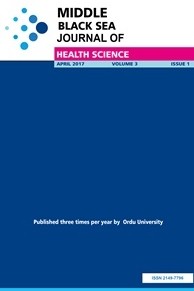Fournier’s Gangrene: Our Clinical Experience and Outcomes
Fournier’s gangrene, debridement, experience
Fournier’s Gangrene: Our Clinical Experience and Outcomes
Fournier’s gangrene, debridement, experience,
___
- 1. Grzybowski A. A short history of Fournier gangrene. Arch Dermatol. 2009;145(2):182.
- 2. Sallami S, Maalla R, Gammoudi A, Ben Jdidia G, Tarhouni L, Horchani A. Fournier's gangrene: what are the prognostic factors? Our experience with 40 patients. Tunis Med. 2012;90(10):708-14.
- 3. Thwaini A, Khan A, Malik A, Cherian J, Barua J, Shergill I, Mammen K. Fournier's gangrene and its emergency management. Postgrad Med J. 2006;82(970):516-9.
- 4. Eke N. Fournier's gangrene: a review of 1726 cases. Br J Surg. 2000;87(6):718-28.
- 5. Çalışkan S, Özsoy E, Sungur M, Gözdaş HT. Fournier's gangrene: Review of 36 cases. Ulus Journal of Trauma Emergency Surgery 2019;25(5):479-483.
- 6. Singh A, Ahmed K, Aydin A, Khan MS, Dasgupta P. Fournier's gangrene. A clinical review. Arch Ital Urol Androl. 2016;88(3):157-164.
- 7. Taviloglu K, Cabioglu N, Cagatay A, Yanar H, Ertekin C, Baspinar I, Ozsut H, Guloglu R. Idiopathic necrotizing fasciitis: risk factors and strategies for management. Am Surg. 2005;71(4):315-20.
- 8. Korkut M, Icoz G, Dayangac M, Akgun E, Yeniay L, Erdogan O, Cal C. Outcome analysis in patients with Fournier's gangrene: report of 45 cases. Dis Colon Rectum. 2003;46(5):649-52.
- 9. Kamper L, Piroth W, Haage P. Fournier-Gangrän mit letalem Verlauf bei einer Patientin mit Diabetes mellitus [Fournier gangrene (necrotizing fasciitis) in a woman with diabetes mellitus]. Dtsch Med Wochenschr. 2009 Aug;134(33):1625-8. German.
- 10. Fajdic J, Gotovac N, Hrgovic Z. Fournier gangrene: our approach and patients. Urol Int. 2011;87(2):186-91.
- 11. Malik AM, Sheikh S, Pathan R, Khan A, Sheikh U. The spectrum of presentation and management of Fournier's gangrene--an experience of 73 cases. J Pak Med Assoc. 2010;60(8):617-9.
- 12. Korhonen K, Hirn M, Niinikoski J. Hyperbaric oxygen in the treatment of Fournier's gangrene. Eur J Surg. 1998;164(4):251-5.
- 13. Mindrup SR, Kealey GP, Fallon B. Hyperbaric oxygen for the treatment of fournier's gangrene. J Urol. 2005;173(6):1975-7.
- 14. Chernyadyev SA, Ufimtseva MA, Vishnevskaya IF, Bochkarev YM, Ushakov AA, Beresneva TA, Galimzyanov FV, Khodakov VV. Fournier's Gangrene: Literature Review and Clinical Cases. Urol Int. 2018;101(1):91-97.
- Yayın Aralığı: Yılda 4 Sayı
- Başlangıç: 2015
- Yayıncı: Ordu Üniversitesi
Tuğrul KESİCİOĞLU, İsmail AYDIN, Selahattin VURAL, İlkay ÇİNAR, Mehmet GÜLMEZ, Arif KESKİN
Shylaja J, Huda MOHAMMED TALEA ASİRİ, Nouf MOHAMMED AHMAED AL MAKTHER, Alaa AHMAD ALSAYED, Hind ALI AYED ALHBIRY ASIRI, Fathima ALİ MOHAMMED AQİLİ, Amal HABIB MOHAMMED ALAMMARI
Analysis of Forensic Geriatric Patients Admitted to Emergency Department
Meltem KÖKDENER, Latif DURAN, İskender AKSOY, Mehmet EKİZ
Elif Bahar ÇAKICI, Kezban Meltem ÇOLAK
Estimating Height and Body Weight Using Foot Measurements
Laboratory Parameters and Clinical Courses in Covid-19 Prognosis: Case Reports
Ufuk KAYA, Elif GÜNEŞ, Elif EREN, Mohammed ISSA, Emrah GÜLER, Aslı AYKAÇ, Nedim CAKİR, Kaya SÜER
Frequency of Paroxysmal Nocturnal Hemoglobinuria in Patients with Lymphoma
Muhammet ÖZBİLEN, Aysın TULUNAY VİRLAN, Abdullah HACIHANEFİOĞLU
Ömer Faruk ŞAHİN, Mehmet Semih ÇAKIR, Muhammet Teoman KARAKURT, Veysel ANTAR
